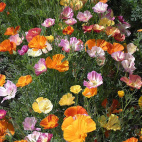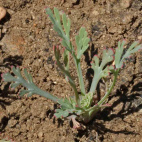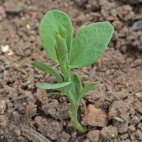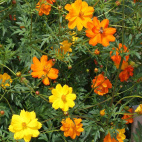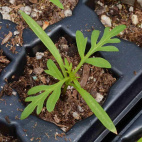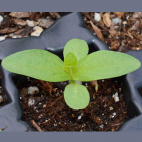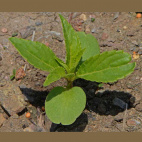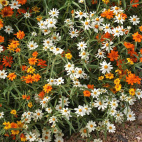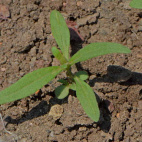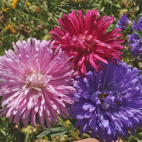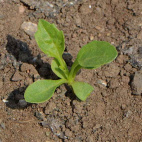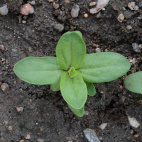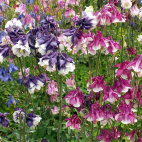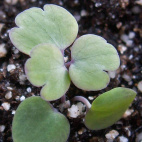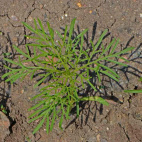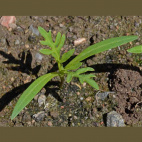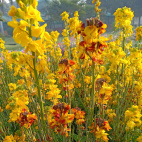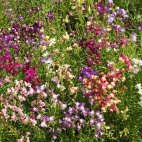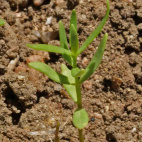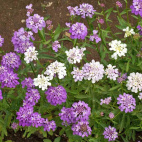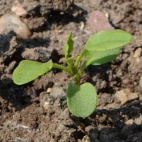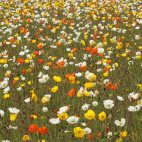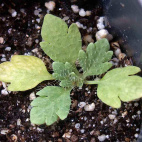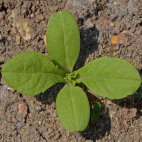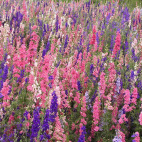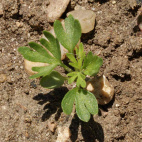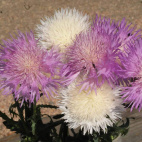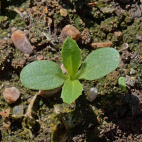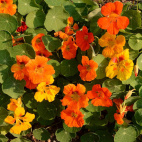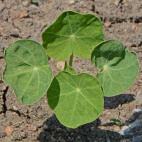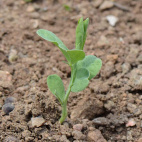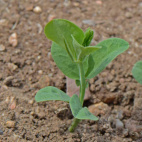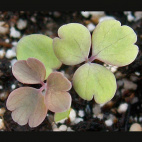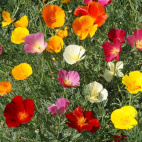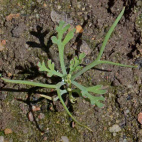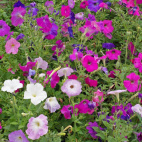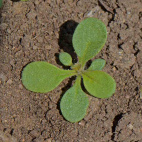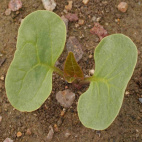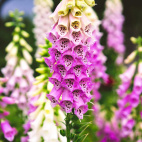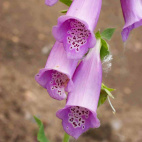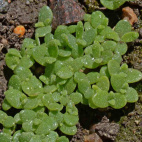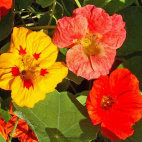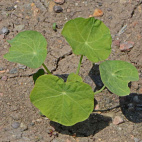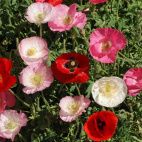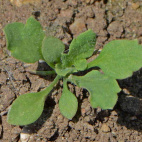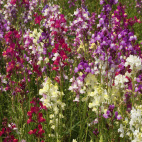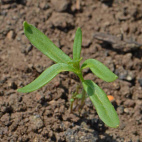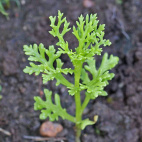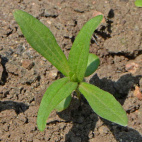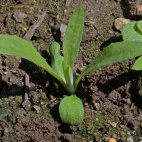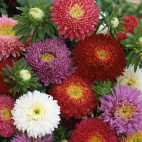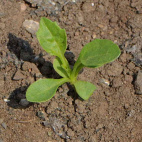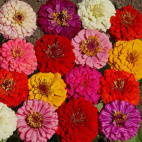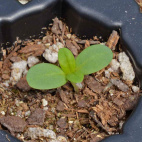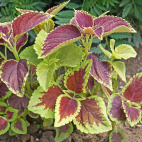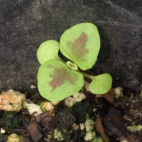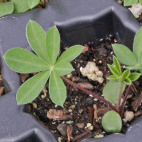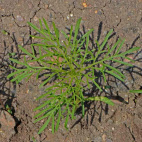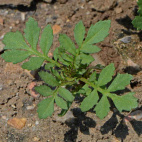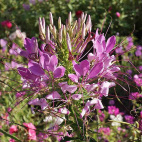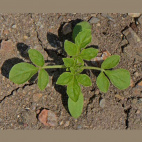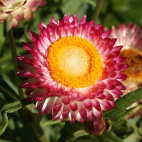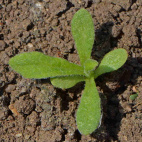Color
Availability
USDA Zone
Region
Type
Duration
Season
Germination
Soil
Sunlight
Height
Use
Narrow Your Search
Color
Availability
USDA Zone
Region
Type
Duration
Season
Germination
Soil
Sunlight
Height
Use
Wildflower Seeds - California Region
-
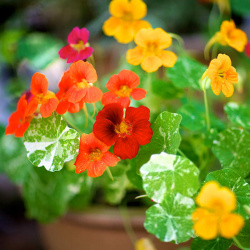 Alaska Nasturtium Seed Mix
Tropaeolum nanum
A dwarf variety, this mix comes in lovely shades of gold, orange, red, and yellow. This annual also has variegated leaves and is easy to grow, making it easy to have a beautiful flower bed with minimal effort.Quick View$3.48 Pkt - $6.84 / Oz
Alaska Nasturtium Seed Mix
Tropaeolum nanum
A dwarf variety, this mix comes in lovely shades of gold, orange, red, and yellow. This annual also has variegated leaves and is easy to grow, making it easy to have a beautiful flower bed with minimal effort.Quick View$3.48 Pkt - $6.84 / Oz -
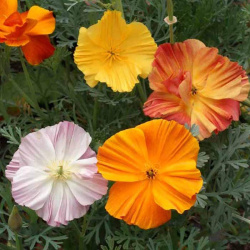 On Sale!
Ballerina California Poppy Seed Mix
Eschscholzia californica
Beautiful shades of red, pink, and gold will dazzle the eye with this popular California Poppy mix. The silky, cup-shaped flowers form on slender stems just like the common Orange California Poppy, but this shows off with many more colors.Quick Viewx
On Sale!
Ballerina California Poppy Seed Mix
Eschscholzia californica
Beautiful shades of red, pink, and gold will dazzle the eye with this popular California Poppy mix. The silky, cup-shaped flowers form on slender stems just like the common Orange California Poppy, but this shows off with many more colors.Quick ViewxBallerina California Poppy Seed Mix
Eschscholzia californica
Beautiful shades of red, pink, and gold will dazzle the eye with this popular California Poppy mix. The silky, cup-shaped flowers form on slender stems just like the common Orange California Poppy, but this shows off with many more colors.
$3.48 Pkt - $13.00 / Oz -
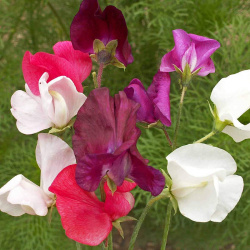 Bijou Sweet Pea Seed Mix
Lathyrus odoratus
This dwarf Sweet Pea variety produces masses of fragrant flowers on sturdy, bushy plants. Perfect for bouquets, this mix includes red, pink, purple, blue, and white. This annual is very easy to grow and is a must for those who love various aromas in their garden.Quick Viewx
Bijou Sweet Pea Seed Mix
Lathyrus odoratus
This dwarf Sweet Pea variety produces masses of fragrant flowers on sturdy, bushy plants. Perfect for bouquets, this mix includes red, pink, purple, blue, and white. This annual is very easy to grow and is a must for those who love various aromas in their garden.Quick ViewxBijou Sweet Pea Seed Mix
Lathyrus odoratus
This dwarf Sweet Pea variety produces masses of fragrant flowers on sturdy, bushy plants. Perfect for bouquets, this mix includes red, pink, purple, blue, and white. This annual is very easy to grow and is a must for those who love various aromas in their garden.
$3.75 Pkt - $9.35 / Oz -
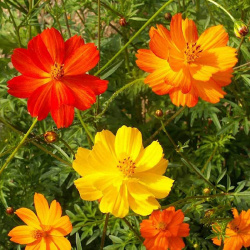 Bright Lights Sulphur Cosmos Seed Mix
Cosmos sulphureus
Light up the landscape with these cheerful red, orange, and yellow blossoms that are shorter than most Cosmos varieties. This easy-to-grow annual will reward the gardener who does not have much time to fuss with plants.Quick View$3.48 Pkt - $7.01 / Oz
Bright Lights Sulphur Cosmos Seed Mix
Cosmos sulphureus
Light up the landscape with these cheerful red, orange, and yellow blossoms that are shorter than most Cosmos varieties. This easy-to-grow annual will reward the gardener who does not have much time to fuss with plants.Quick View$3.48 Pkt - $7.01 / Oz -
 California Giants Zinnia Seed Mix
Zinnia elegans
These enormous zinnias come in a stunning mix of pink, purple, red, orange, white, and yellow. This easy-to-grow annual blooms all summer long, and will attract butterflies to your yard and garden.Quick View$3.48 Pkt - $7.59 / Oz
California Giants Zinnia Seed Mix
Zinnia elegans
These enormous zinnias come in a stunning mix of pink, purple, red, orange, white, and yellow. This easy-to-grow annual blooms all summer long, and will attract butterflies to your yard and garden.Quick View$3.48 Pkt - $7.59 / Oz -
 Camilia Flowered Balsam Seed Mix
Impatiens balsamina
A Victorian favorite, this beautiful heirloom annual is an excellent choice for containers or as a border plant. The large, double blossoms come in a mix of rose, white, scarlet, and violet.Quick View$3.48 Pkt - $7.65 / Oz
Camilia Flowered Balsam Seed Mix
Impatiens balsamina
A Victorian favorite, this beautiful heirloom annual is an excellent choice for containers or as a border plant. The large, double blossoms come in a mix of rose, white, scarlet, and violet.Quick View$3.48 Pkt - $7.65 / Oz -
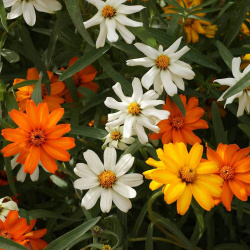 Classic Zinnia Seeds
Zinnia linearis
This time-honored Zinnia variety produces orange, yellow, and white blossoms on compact, bushy plants. These flowers are more like a daisy than many Zinnias, but they are still well-loved by the bees and butterflies.Quick View$3.48 Pkt - $32.00 / Oz
Classic Zinnia Seeds
Zinnia linearis
This time-honored Zinnia variety produces orange, yellow, and white blossoms on compact, bushy plants. These flowers are more like a daisy than many Zinnias, but they are still well-loved by the bees and butterflies.Quick View$3.48 Pkt - $32.00 / Oz -
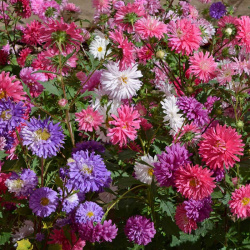 Crego China Aster Seed Mix
Callistephus chinensis
A stunning cut flower, these large blossoms grow in lovely pastel shades of pink, red, violet, and white. This easy-to-grow annual aster will readily reseed itself.Quick Viewx
Crego China Aster Seed Mix
Callistephus chinensis
A stunning cut flower, these large blossoms grow in lovely pastel shades of pink, red, violet, and white. This easy-to-grow annual aster will readily reseed itself.Quick ViewxCrego China Aster Seed Mix
Callistephus chinensis
A stunning cut flower, these large blossoms grow in lovely pastel shades of pink, red, violet, and white. This easy-to-grow annual aster will readily reseed itself.
$3.48 Pkt - $7.59 / Oz -
 Dahlia Flowered Zinnia Seed Mix
Zinnia elegans
These bright flowers come in a splendid array of colors and are shaped like Dahlias. This easy-to-grow annual blooms all summer long, and catches the attention of wandering butterflies.Quick View$3.48 Pkt - $7.59 / Oz
Dahlia Flowered Zinnia Seed Mix
Zinnia elegans
These bright flowers come in a splendid array of colors and are shaped like Dahlias. This easy-to-grow annual blooms all summer long, and catches the attention of wandering butterflies.Quick View$3.48 Pkt - $7.59 / Oz -
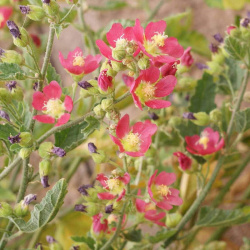 Desert Globemallow Seeds
Sphaeralcea ambigua
Native to the American southwest and Mexico, this shrub bears beautiful blossoms that vary in color from pink to orange. This tough little perennial grows well in poor soil and can handle the intense heat and drought of the desert southwest, making it an ideal plant for xeriscaping.Quick Viewx
Desert Globemallow Seeds
Sphaeralcea ambigua
Native to the American southwest and Mexico, this shrub bears beautiful blossoms that vary in color from pink to orange. This tough little perennial grows well in poor soil and can handle the intense heat and drought of the desert southwest, making it an ideal plant for xeriscaping.Quick ViewxDesert Globemallow Seeds
Sphaeralcea ambigua
Native to the American southwest and Mexico, this shrub bears beautiful blossoms that vary in color from pink to orange. This tough little perennial grows well in poor soil and can handle the intense heat and drought of the desert southwest, making it an ideal plant for xeriscaping.
$3.48 Pkt - $20.16 / Oz -
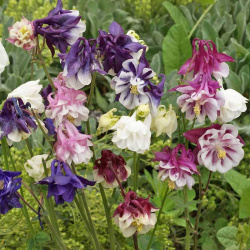 Dwarf Columbine Seed Mix
Aquilegia vulgaris
These delicate, nodding blossoms grow wild throughout much of northern Europe. This 16" dwarf variety produces a lovely mix of colors that will brighten any space!Quick View$3.48 Pkt - $12.65 / Oz
Dwarf Columbine Seed Mix
Aquilegia vulgaris
These delicate, nodding blossoms grow wild throughout much of northern Europe. This 16" dwarf variety produces a lovely mix of colors that will brighten any space!Quick View$3.48 Pkt - $12.65 / Oz -
 On Sale!
Dwarf Cosmos Seed Mix
Cosmos bipinnatus
These showy, colorful blossoms will have the neighbors talking. This easy-to-grow annual is shorter than most Cosmos varieties, so it fits well in smaller spaces. Cosmos is great for butterfly gardens and cut flower gardens alike.Quick View$3.48 Pkt - $7.92 / Oz
On Sale!
Dwarf Cosmos Seed Mix
Cosmos bipinnatus
These showy, colorful blossoms will have the neighbors talking. This easy-to-grow annual is shorter than most Cosmos varieties, so it fits well in smaller spaces. Cosmos is great for butterfly gardens and cut flower gardens alike.Quick View$3.48 Pkt - $7.92 / Oz -
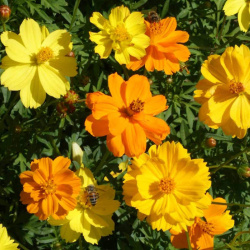 Dwarf Sulphur Cosmos Seed Mix
Cosmos sulphureus
Compact in size, this bright mix of gold, orange, and red Cosmos is sure to please. A good choice for the undecided, because it includes many colors. This annual wildflower is simple to grow and produces blooms in the first year.Quick View$3.48 Pkt - $8.70 / Oz
Dwarf Sulphur Cosmos Seed Mix
Cosmos sulphureus
Compact in size, this bright mix of gold, orange, and red Cosmos is sure to please. A good choice for the undecided, because it includes many colors. This annual wildflower is simple to grow and produces blooms in the first year.Quick View$3.48 Pkt - $8.70 / Oz -
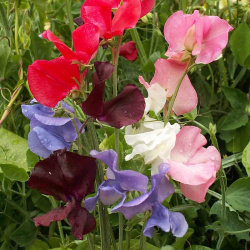 Early Multiflora Sweet Pea Seed Mix
Lathyrus odoratus
These annual vines produce an explosion of color and fragrance that will envelop you. This variety grows quite tall and includes blooms that are purple, fuchsia, red, pink, white, and blue. So easy to grow!Quick View$3.48 Pkt - $8.93 / Oz
Early Multiflora Sweet Pea Seed Mix
Lathyrus odoratus
These annual vines produce an explosion of color and fragrance that will envelop you. This variety grows quite tall and includes blooms that are purple, fuchsia, red, pink, white, and blue. So easy to grow!Quick View$3.48 Pkt - $8.93 / Oz -
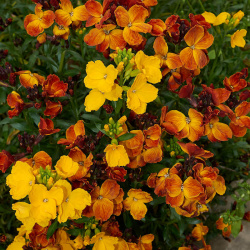 English Wallflower Seeds
Cheiranthus cheiri
This old English favorite pops up in castle ruins, roadsides, or any bit of rocky soil near the sea. The phlox-like orange blossoms also give off a pleasant fragrance.Quick View$2.98 Pkt - $8.46 / Oz
English Wallflower Seeds
Cheiranthus cheiri
This old English favorite pops up in castle ruins, roadsides, or any bit of rocky soil near the sea. The phlox-like orange blossoms also give off a pleasant fragrance.Quick View$2.98 Pkt - $8.46 / Oz -
 Fairy Bouquet Snapdragon Seed Mix
Linaria maroccana
Plant a fairytale garden with these dainty jewel-like beauties. This delightful annual is popular for containers or borders and makes an excellent cut flower as well. It is easy to grow and does not take up much space in the garden.Quick View$2.98 Pkt - $8.93 / Oz
Fairy Bouquet Snapdragon Seed Mix
Linaria maroccana
Plant a fairytale garden with these dainty jewel-like beauties. This delightful annual is popular for containers or borders and makes an excellent cut flower as well. It is easy to grow and does not take up much space in the garden.Quick View$2.98 Pkt - $8.93 / Oz -
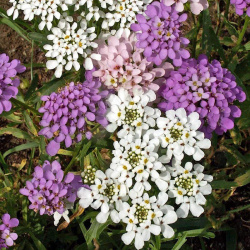 Globe Annual Candytuft Seeds
Iberis umbellata
This easy-to-grow favorite comes in lovely shades of pink, purple, and white. The fragrant perennial is perfect for a cottage garden or butterfly garden.Quick View$3.48 Pkt - $7.27 / Oz
Globe Annual Candytuft Seeds
Iberis umbellata
This easy-to-grow favorite comes in lovely shades of pink, purple, and white. The fragrant perennial is perfect for a cottage garden or butterfly garden.Quick View$3.48 Pkt - $7.27 / Oz -
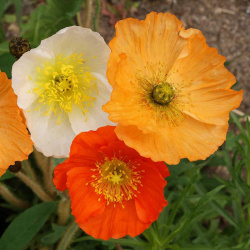 On Sale!
Iceland Poppy Seeds
Papaver nudicaule
This hardy poppy comes from the arctic regions of Canada and Europe, so makes an excellent choice for areas with harsh winters. The large blossoms often self-sow and are highly attractive to bees and butterflies.Quick View$3.48 Pkt - $13.34 / Oz
On Sale!
Iceland Poppy Seeds
Papaver nudicaule
This hardy poppy comes from the arctic regions of Canada and Europe, so makes an excellent choice for areas with harsh winters. The large blossoms often self-sow and are highly attractive to bees and butterflies.Quick View$3.48 Pkt - $13.34 / Oz -
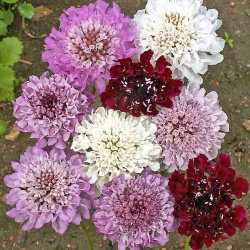 Imperial Pincushion Flower Seed Mix
Scabiosa atropurpurea
This fragrant, old-fashioned flower comes in lovely shades of pink, blue-violet, lavender, and white. The popular powder puff blooms make a terrific cut flower that will allow you to fill your home with the wonderful scent.Quick View$3.48 Pkt - $12.65 / Oz
Imperial Pincushion Flower Seed Mix
Scabiosa atropurpurea
This fragrant, old-fashioned flower comes in lovely shades of pink, blue-violet, lavender, and white. The popular powder puff blooms make a terrific cut flower that will allow you to fill your home with the wonderful scent.Quick View$3.48 Pkt - $12.65 / Oz -
 Imperial Rocket Larkspur Seed Mix
Delphinium consolida
Blossoming in blue, pink, white, and purple, these colorful flowers are easy to grow, making them popular in many annual flower gardens. The hummingbirds will be humming over your garden, and you can also cut the flowers and enjoy them inside as well.Quick Viewx
Imperial Rocket Larkspur Seed Mix
Delphinium consolida
Blossoming in blue, pink, white, and purple, these colorful flowers are easy to grow, making them popular in many annual flower gardens. The hummingbirds will be humming over your garden, and you can also cut the flowers and enjoy them inside as well.Quick ViewxImperial Rocket Larkspur Seed Mix
Delphinium consolida
Blossoming in blue, pink, white, and purple, these colorful flowers are easy to grow, making them popular in many annual flower gardens. The hummingbirds will be humming over your garden, and you can also cut the flowers and enjoy them inside as well.
$3.48 Pkt - $7.52 / Oz -
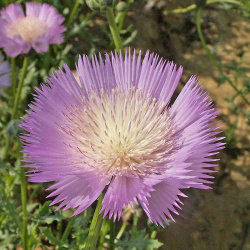 Imperialis Sweet Sultan Seed Mix
Amberboa moschata
These colorful, sweetly scented powder puffs are a cottage garden favorite. The easy-to-grow annual is excellent for cut flowers.Quick Viewx
Imperialis Sweet Sultan Seed Mix
Amberboa moschata
These colorful, sweetly scented powder puffs are a cottage garden favorite. The easy-to-grow annual is excellent for cut flowers.Quick ViewxImperialis Sweet Sultan Seed Mix
Amberboa moschata
These colorful, sweetly scented powder puffs are a cottage garden favorite. The easy-to-grow annual is excellent for cut flowers.
$3.48 Pkt - $8.70 / Oz -
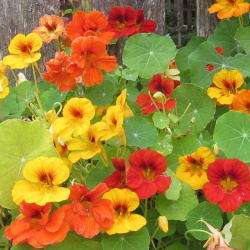 Jewel Nasturtium Seed Mix
Tropaeolum nanum
Like sparkling jewels, this beautiful mix of variegated gold, orange, red, and yellow will delight the eyes. This annual is easy to grow and can be easily grown by the gardening novice.Quick View$3.48 Pkt - $6.84 / Oz
Jewel Nasturtium Seed Mix
Tropaeolum nanum
Like sparkling jewels, this beautiful mix of variegated gold, orange, red, and yellow will delight the eyes. This annual is easy to grow and can be easily grown by the gardening novice.Quick View$3.48 Pkt - $6.84 / Oz -
 Knee High Sweet Pea Seed Mix
Lathyrus odoratus
Ideal for hanging baskets or window boxes, this bushy, semi-dwarf variety is just the right height. The sweet-scented blossoms show off in red, fuchsia, purple, and white. This annual is super easy to grow and will bloom in its first growing season.Quick View$3.48 Pkt - $9.54 / Oz
Knee High Sweet Pea Seed Mix
Lathyrus odoratus
Ideal for hanging baskets or window boxes, this bushy, semi-dwarf variety is just the right height. The sweet-scented blossoms show off in red, fuchsia, purple, and white. This annual is super easy to grow and will bloom in its first growing season.Quick View$3.48 Pkt - $9.54 / Oz -
 Lilliput Zinnia Seed Mix
Zinnia elegans
Shaped like little pom-poms, these bright flowers add pop and color to garden and bouquet. This flower is a semi-dwarf Zinnia and works well for planting into containers or small gardens. It is also an annual flower that is very easy to grow and does not need much fussing.Quick Viewx
Lilliput Zinnia Seed Mix
Zinnia elegans
Shaped like little pom-poms, these bright flowers add pop and color to garden and bouquet. This flower is a semi-dwarf Zinnia and works well for planting into containers or small gardens. It is also an annual flower that is very easy to grow and does not need much fussing.Quick ViewxLilliput Zinnia Seed Mix
Zinnia elegans
Shaped like little pom-poms, these bright flowers add pop and color to garden and bouquet. This flower is a semi-dwarf Zinnia and works well for planting into containers or small gardens. It is also an annual flower that is very easy to grow and does not need much fussing.
$3.48 Pkt - $7.59 / Oz -
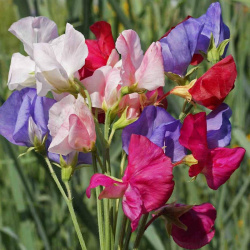 Mammoth Sweet Pea Seed Mix
Lathyrus odoratus
These large, ruffled blooms are sure to impress with lovely shades of pink, red, blue, lilac, and white. These heat-resistant vines flower well into the summer, filling every corner of the garden with their sweet perfumes. This flower is an easy to grow annual that will grow in almost any garden spot.Quick Viewx
Mammoth Sweet Pea Seed Mix
Lathyrus odoratus
These large, ruffled blooms are sure to impress with lovely shades of pink, red, blue, lilac, and white. These heat-resistant vines flower well into the summer, filling every corner of the garden with their sweet perfumes. This flower is an easy to grow annual that will grow in almost any garden spot.Quick ViewxMammoth Sweet Pea Seed Mix
Lathyrus odoratus
These large, ruffled blooms are sure to impress with lovely shades of pink, red, blue, lilac, and white. These heat-resistant vines flower well into the summer, filling every corner of the garden with their sweet perfumes. This flower is an easy to grow annual that will grow in almost any garden spot.
$3.48 Pkt - $9.71 / Oz -
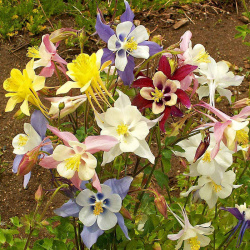 McKana Giants Columbine Seed Mix
Aquilegia caerulea
Developed explicitly for its large colorful blooms, this AAS Award winner first became available in the 1950s. A striking choice for any gardener who loves the distinctive columbine shaped flowers.Quick View$3.48 Pkt - $20.16 / Oz
McKana Giants Columbine Seed Mix
Aquilegia caerulea
Developed explicitly for its large colorful blooms, this AAS Award winner first became available in the 1950s. A striking choice for any gardener who loves the distinctive columbine shaped flowers.Quick View$3.48 Pkt - $20.16 / Oz -
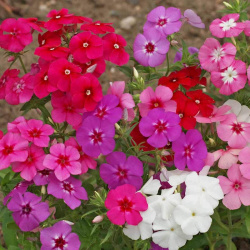 On Sale!
Annual Phlox Seed Mix
Phlox drummondii
Bearing clusters of lovely, fragrant flowers, this popular mix blooms in pink, red, rose, purple, and white. This mix is most often planted en masse so that the variegated colors can be more fully seen. This annual is very easy to grow and will attract a variety of pollinators to your garden.Quick Viewx
On Sale!
Annual Phlox Seed Mix
Phlox drummondii
Bearing clusters of lovely, fragrant flowers, this popular mix blooms in pink, red, rose, purple, and white. This mix is most often planted en masse so that the variegated colors can be more fully seen. This annual is very easy to grow and will attract a variety of pollinators to your garden.Quick ViewxAnnual Phlox Seed Mix
Phlox drummondii
Bearing clusters of lovely, fragrant flowers, this popular mix blooms in pink, red, rose, purple, and white. This mix is most often planted en masse so that the variegated colors can be more fully seen. This annual is very easy to grow and will attract a variety of pollinators to your garden.
$3.25 Pkt - $10.04 / Oz -
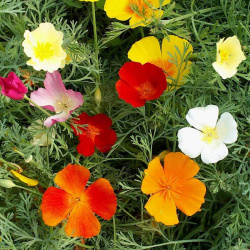 California Poppy Seed Mix
Eschscholzia californica
Can't decide which color of California Poppy seeds to buy? Experience a dazzling array of different colors with a carpet of this California Poppy mix. This mix is very easy to grow and is great for beginning gardeners.Quick View$2.98 Pkt - $8.46 / Oz
California Poppy Seed Mix
Eschscholzia californica
Can't decide which color of California Poppy seeds to buy? Experience a dazzling array of different colors with a carpet of this California Poppy mix. This mix is very easy to grow and is great for beginning gardeners.Quick View$2.98 Pkt - $8.46 / Oz -
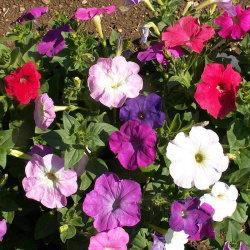 Dwarf Petunia Seed Mix
Petunia nana compacta
Bring back a garden favorite from the 1950s with this bright multicolored mix. The sturdy and compact growth of this annual is perfect for mass planting, hanging baskets, or container gardening.Quick View$3.48 Pkt - $17.72 / Oz
Dwarf Petunia Seed Mix
Petunia nana compacta
Bring back a garden favorite from the 1950s with this bright multicolored mix. The sturdy and compact growth of this annual is perfect for mass planting, hanging baskets, or container gardening.Quick View$3.48 Pkt - $17.72 / Oz -
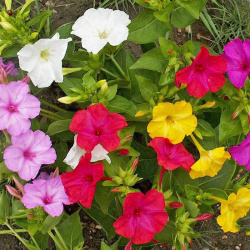 Four O'clock Seed Mix
Mirabilis jalapa
This flower has a habit of opening in the late afternoon, an unusual feature that is caused by changes in light and temperature. This garden favorite produces fragrant blossoms in brilliant pink, rose, red, white, and yellow.Quick View$3.48 Pkt - $5.96 / Oz
Four O'clock Seed Mix
Mirabilis jalapa
This flower has a habit of opening in the late afternoon, an unusual feature that is caused by changes in light and temperature. This garden favorite produces fragrant blossoms in brilliant pink, rose, red, white, and yellow.Quick View$3.48 Pkt - $5.96 / Oz -
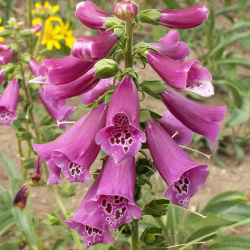 On Sale!
Foxglove Seed Mix
Digitalis purpurea
Straight from the storybooks, this old-fashioned favorite brings a special charm to cottage gardens. The colorful blossoms of the Digitalis Purpurea are easy to grow, and also attract hummingbirds and butterflies.Quick View$3.48 Pkt - $11.47 / Oz
On Sale!
Foxglove Seed Mix
Digitalis purpurea
Straight from the storybooks, this old-fashioned favorite brings a special charm to cottage gardens. The colorful blossoms of the Digitalis Purpurea are easy to grow, and also attract hummingbirds and butterflies.Quick View$3.48 Pkt - $11.47 / Oz -
 On Sale!
Ice Plant Seed Mix
Mesembryanthemem criniflorum
This plant's unusual name was most likely inspired by the crystal-like texture of its foliage. This vibrant annual also produces masses of daisy-like flowers in red, orange, yellow, pink, white, or purple.Quick View$2.98 Pkt - $8.20 / Oz
On Sale!
Ice Plant Seed Mix
Mesembryanthemem criniflorum
This plant's unusual name was most likely inspired by the crystal-like texture of its foliage. This vibrant annual also produces masses of daisy-like flowers in red, orange, yellow, pink, white, or purple.Quick View$2.98 Pkt - $8.20 / Oz -
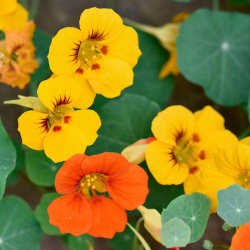 On Sale!
Tall Nasturtium Seed Mix
Tropaeolum majus
Scatter these seeds anywhere for a gorgeous mix of large gold, orange, red, and yellow blossoms. This popular annual is tall for the nasturtium family, so it will need more room than the dwarf varieties. This flower is easy to grow and is a good wildflower for the beginning gardener.Quick Viewx
On Sale!
Tall Nasturtium Seed Mix
Tropaeolum majus
Scatter these seeds anywhere for a gorgeous mix of large gold, orange, red, and yellow blossoms. This popular annual is tall for the nasturtium family, so it will need more room than the dwarf varieties. This flower is easy to grow and is a good wildflower for the beginning gardener.Quick ViewxTall Nasturtium Seed Mix
Tropaeolum majus
Scatter these seeds anywhere for a gorgeous mix of large gold, orange, red, and yellow blossoms. This popular annual is tall for the nasturtium family, so it will need more room than the dwarf varieties. This flower is easy to grow and is a good wildflower for the beginning gardener.
$3.48 Pkt - $5.96 / Oz -
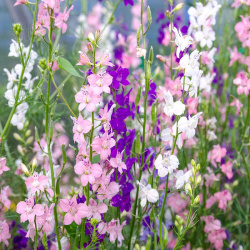 Rocket Larkspur Seed Mix
Delphinium ajacis
Blossoming in pink, blue, and white, these colorful spikes will bedazzle the eye. Larkspur is a favorite flower for many annual flower gardens and makes a beautiful cut flower as well. Hummingbirds love to visit this plant too.Quick View$3.48 Pkt - $7.59 / Oz
Rocket Larkspur Seed Mix
Delphinium ajacis
Blossoming in pink, blue, and white, these colorful spikes will bedazzle the eye. Larkspur is a favorite flower for many annual flower gardens and makes a beautiful cut flower as well. Hummingbirds love to visit this plant too.Quick View$3.48 Pkt - $7.59 / Oz -
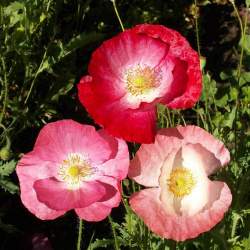 Single Poppy Seed Mix
Papaver rhoeas
Create a shimmering wave of color with this bright mix, which contains the super-popular Red Poppy, along with pink and white variations. This annual often self-sows and is highly attractive to bees, butterflies, and birds.Quick View$2.98 Pkt - $7.59 / Oz
Single Poppy Seed Mix
Papaver rhoeas
Create a shimmering wave of color with this bright mix, which contains the super-popular Red Poppy, along with pink and white variations. This annual often self-sows and is highly attractive to bees, butterflies, and birds.Quick View$2.98 Pkt - $7.59 / Oz -
 Northern Lights Snapdragon Seed Mix
Linaria maroccana
This exquisite annual will transform a meadow into a shimmering sea of color. Also popular for containers, this mix includes white, rose, lilac, yellow, orange, and crimson flowers. Every flower garden needs a few Snapdragons!Quick View$2.98 Pkt - $8.46 / Oz
Northern Lights Snapdragon Seed Mix
Linaria maroccana
This exquisite annual will transform a meadow into a shimmering sea of color. Also popular for containers, this mix includes white, rose, lilac, yellow, orange, and crimson flowers. Every flower garden needs a few Snapdragons!Quick View$2.98 Pkt - $8.46 / Oz -
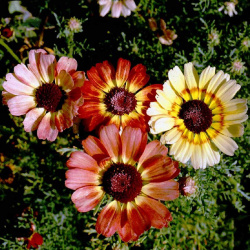 Painted Daisy Seeds
Chrysanthemum carinatum
An annual from the coasts of North Africa, this particular daisy variety boasts a boast a tricolor ring pattern. This showy wildflower blooms through summer and fall and then reseeds itself for the next year's blooms.Quick View$3.48 Pkt - $7.59 / Oz
Painted Daisy Seeds
Chrysanthemum carinatum
An annual from the coasts of North Africa, this particular daisy variety boasts a boast a tricolor ring pattern. This showy wildflower blooms through summer and fall and then reseeds itself for the next year's blooms.Quick View$3.48 Pkt - $7.59 / Oz -
 On Sale!
Persian Carpet Zinnia Seeds
Zinnia haageana
Get a taste of the exotic with this warm bi-color mix of scarlet, gold, orange, chocolate, bronze, and cream. This dwarf variety blooms all summer long and is very easy to grow. It can even be grown in containers or as a ground cover.Quick View$3.48 Pkt - $15.72 / Oz
On Sale!
Persian Carpet Zinnia Seeds
Zinnia haageana
Get a taste of the exotic with this warm bi-color mix of scarlet, gold, orange, chocolate, bronze, and cream. This dwarf variety blooms all summer long and is very easy to grow. It can even be grown in containers or as a ground cover.Quick View$3.48 Pkt - $15.72 / Oz -
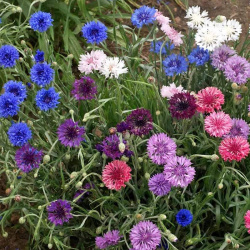 Polka Dot Bachelor Button Seed Mix
Centaurea cyanus
This easy-to-grow favorite annual comes in a bright mix of blue, purple, pink, white, and rose. Excellent for dried flower arrangements or potpourri. The plant is a dwarf, so it is great for gardens with limited space.Quick View$3.48 Pkt - $5.96 / Oz
Polka Dot Bachelor Button Seed Mix
Centaurea cyanus
This easy-to-grow favorite annual comes in a bright mix of blue, purple, pink, white, and rose. Excellent for dried flower arrangements or potpourri. The plant is a dwarf, so it is great for gardens with limited space.Quick View$3.48 Pkt - $5.96 / Oz -
 Powder Puff China Aster Seed Mix
Callistephus chinensis
Popular for cut flowers, this double flower blooms in red, purple, blue, and white. This easy-to-grow annual will reseed itself for the next growing season.Quick View$3.48 Pkt - $7.65 / Oz
Powder Puff China Aster Seed Mix
Callistephus chinensis
Popular for cut flowers, this double flower blooms in red, purple, blue, and white. This easy-to-grow annual will reseed itself for the next growing season.Quick View$3.48 Pkt - $7.65 / Oz -
 Pumila Zinnia Seed Mix
Zinnia elegans
An old-time garden favorite, these Pumila Zinnias come in a lovely mix of pink, purple, orange, red, white, and yellow. This Zinnia is smaller than some, so it is an excellent option for small gardens, containers, or tight spaces. This annual is easy to grow and does not require much care.Quick Viewx
Pumila Zinnia Seed Mix
Zinnia elegans
An old-time garden favorite, these Pumila Zinnias come in a lovely mix of pink, purple, orange, red, white, and yellow. This Zinnia is smaller than some, so it is an excellent option for small gardens, containers, or tight spaces. This annual is easy to grow and does not require much care.Quick ViewxPumila Zinnia Seed Mix
Zinnia elegans
An old-time garden favorite, these Pumila Zinnias come in a lovely mix of pink, purple, orange, red, white, and yellow. This Zinnia is smaller than some, so it is an excellent option for small gardens, containers, or tight spaces. This annual is easy to grow and does not require much care.
$3.48 Pkt - $7.65 / Oz -
 Rainbow Coleus Seed Mix
Solenostemon scutellarioides
Also known as Painted Leaves, this Coleus mix will bring brilliant colors to your shady garden area. This short annual is a perfect choice for borders or containers and will behave well as a house plant too.Quick View$3.75 Pkt - $36.00 / Oz
Rainbow Coleus Seed Mix
Solenostemon scutellarioides
Also known as Painted Leaves, this Coleus mix will bring brilliant colors to your shady garden area. This short annual is a perfect choice for borders or containers and will behave well as a house plant too.Quick View$3.75 Pkt - $36.00 / Oz -
 On Sale!
Russell Lupine Seeds
Lupinus polyphyllus
Brilliant and bold in a rainbow of colors; this Lupine variety will provide colorful blooms all season. This flower is a cultivated variety of a Lupine that is native to the Pacific Northwest. It grows so quickly and easily that it can almost be invasive with the right growing conditions.Quick Viewx
On Sale!
Russell Lupine Seeds
Lupinus polyphyllus
Brilliant and bold in a rainbow of colors; this Lupine variety will provide colorful blooms all season. This flower is a cultivated variety of a Lupine that is native to the Pacific Northwest. It grows so quickly and easily that it can almost be invasive with the right growing conditions.Quick ViewxRussell Lupine Seeds
Lupinus polyphyllus
Brilliant and bold in a rainbow of colors; this Lupine variety will provide colorful blooms all season. This flower is a cultivated variety of a Lupine that is native to the Pacific Northwest. It grows so quickly and easily that it can almost be invasive with the right growing conditions.
$3.48 Pkt - $8.20 / Oz -
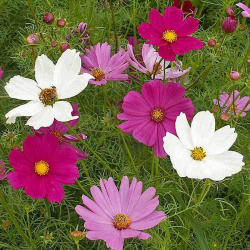 Sensation Tall Cosmos Seed Mix
Cosmos bipinnatus
Create a sensation when these bright blossoms begin to show off in various shades of red, pink, and white! This easy-to-grow annual will enhance any flower garden with little time or effort. Butterflies also love them.Quick View$3.48 Pkt - $7.09 / Oz
Sensation Tall Cosmos Seed Mix
Cosmos bipinnatus
Create a sensation when these bright blossoms begin to show off in various shades of red, pink, and white! This easy-to-grow annual will enhance any flower garden with little time or effort. Butterflies also love them.Quick View$3.48 Pkt - $7.09 / Oz -
 Single China Aster Seed Mix
Callistephus chinensis
This fast-growing annual blooms in beautiful shades of pink, purple, red, and white. The daisy-like flower does reseed itself to produce blooms in the following growing season.Quick Viewx
Single China Aster Seed Mix
Callistephus chinensis
This fast-growing annual blooms in beautiful shades of pink, purple, red, and white. The daisy-like flower does reseed itself to produce blooms in the following growing season.Quick ViewxSingle China Aster Seed Mix
Callistephus chinensis
This fast-growing annual blooms in beautiful shades of pink, purple, red, and white. The daisy-like flower does reseed itself to produce blooms in the following growing season.
$3.48 Pkt - $7.52 / Oz -
 Sparky French Marigold Seed Mix
Tagetes patula
Add extra sparkle to the garden with these vivid orange and yellow stunners. The compact, bushy plants grow quickly and easily from seed, and are sure to please! Some gardeners plant this flower in the garden to repel pests.Quick View$3.48 Pkt - $7.05 / Oz
Sparky French Marigold Seed Mix
Tagetes patula
Add extra sparkle to the garden with these vivid orange and yellow stunners. The compact, bushy plants grow quickly and easily from seed, and are sure to please! Some gardeners plant this flower in the garden to repel pests.Quick View$3.48 Pkt - $7.05 / Oz -
 Spider Plant Seeds
Cleome hassleriana
Traditionally grown in Thomas Jefferson's Monticello estate, this showy Cleome Hassleriana plant bursts with pink and white blossoms. The hardy annual grows relatively tall and readily reseeds itself for the next growing season.Quick View$3.48 Pkt - $8.46 / Oz
Spider Plant Seeds
Cleome hassleriana
Traditionally grown in Thomas Jefferson's Monticello estate, this showy Cleome Hassleriana plant bursts with pink and white blossoms. The hardy annual grows relatively tall and readily reseeds itself for the next growing season.Quick View$3.48 Pkt - $8.46 / Oz -
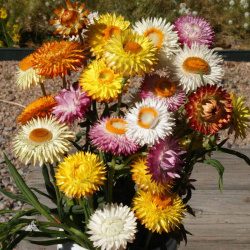 Tall Strawflower Seeds
Helichrysum bracteatum
Originating in Australia, Strawflowers still grow there in the wild. The dried flowers retain lovely shades of yellow, red, orange, pink, and white, which can readily be used in dried flower arrangements.Quick View$3.48 Pkt - $10.45 / Oz
Tall Strawflower Seeds
Helichrysum bracteatum
Originating in Australia, Strawflowers still grow there in the wild. The dried flowers retain lovely shades of yellow, red, orange, pink, and white, which can readily be used in dried flower arrangements.Quick View$3.48 Pkt - $10.45 / Oz















